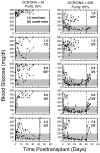Human islet oxygen consumption rate and DNA measurements predict diabetes reversal in nude mice
- PMID: 17229069
- PMCID: PMC2857994
- DOI: 10.1111/j.1600-6143.2006.01655.x
Human islet oxygen consumption rate and DNA measurements predict diabetes reversal in nude mice
Abstract
There is a need for simple, quantitative and prospective assays for islet quality assessment that are predictive of islet transplantation outcome. The current state-of-the-art athymic nude mouse bioassay is costly, technically challenging and retrospective. In this study, we report on the ability of 2 parameters characterizing human islet quality: (1) oxygen consumption rate (OCR), a measure of viable volume; and (2) OCR/DNA, a measure of fractional viability, to predict diabetes reversal in nude mice. Results demonstrate that the probability for diabetes reversal increases as the graft's OCR/DNA and total OCR increase. For a given transplanted OCR dose, diabetes reversal is strongly dependent on OCR/DNA. The OCR and OCR/DNA (the 'OCR test') data exhibit 89% sensitivity and 77% specificity in predicting diabetes reversal in nude mice (n = 86). We conclude that the prospective OCR test can effectively replace the retrospective athymic nude mouse bioassay in assessing human islet quality prior to islet transplantation.
Figures




Similar articles
-
The islet size to oxygen consumption ratio reliably predicts reversal of diabetes posttransplant.Cell Transplant. 2012;21(12):2797-804. doi: 10.3727/096368912X653273. Epub 2012 Aug 27. Cell Transplant. 2012. PMID: 22943589
-
Prediction of marginal mass required for successful islet transplantation.J Invest Surg. 2010 Feb;23(1):28-34. doi: 10.3109/08941930903410825. J Invest Surg. 2010. PMID: 20233002 Free PMC article.
-
The use of the BD oxygen biosensor system to assess isolated human islets of langerhans: oxygen consumption as a potential measure of islet potency.Cell Transplant. 2006;15(8-9):745-58. doi: 10.3727/000000006783981440. Cell Transplant. 2006. PMID: 17269445
-
Islet Oxygen Consumption Rate (OCR) Dose Predicts Insulin Independence in Clinical Islet Autotransplantation.PLoS One. 2015 Aug 10;10(8):e0134428. doi: 10.1371/journal.pone.0134428. eCollection 2015. PLoS One. 2015. PMID: 26258815 Free PMC article.
-
Islet assessment for transplantation.Curr Opin Organ Transplant. 2009 Dec;14(6):674-82. doi: 10.1097/MOT.0b013e328332a489. Curr Opin Organ Transplant. 2009. PMID: 19812494 Free PMC article. Review.
Cited by
-
A predictive computational platform for optimizing the design of bioartificial pancreas devices.Nat Commun. 2022 Oct 13;13(1):6031. doi: 10.1038/s41467-022-33760-5. Nat Commun. 2022. PMID: 36229614 Free PMC article.
-
Transplantation of human islets without immunosuppression.Proc Natl Acad Sci U S A. 2013 Nov 19;110(47):19054-8. doi: 10.1073/pnas.1317561110. Epub 2013 Oct 28. Proc Natl Acad Sci U S A. 2013. PMID: 24167261 Free PMC article.
-
A novel high-throughput assay for islet respiration reveals uncoupling of rodent and human islets.PLoS One. 2012;7(5):e33023. doi: 10.1371/journal.pone.0033023. Epub 2012 May 14. PLoS One. 2012. PMID: 22606219 Free PMC article.
-
Quantitative assessment of β-cell apoptosis and cell composition of isolated, undisrupted human islets by laser scanning cytometry.Transplantation. 2010 Oct 27;90(8):836-42. doi: 10.1097/TP.0b013e3181f1db5d. Transplantation. 2010. PMID: 20697327 Free PMC article.
-
Pancreatic islet cryopreservation by vitrification achieves high viability, function, recovery and clinical scalability for transplantation.Nat Med. 2022 Apr;28(4):798-808. doi: 10.1038/s41591-022-01718-1. Epub 2022 Mar 14. Nat Med. 2022. PMID: 35288694 Free PMC article.
References
-
- Shapiro AM, Lakey JR, Ryan EA, et al. Islet transplantation in seven patients with type 1 diabetes mellitus using a glucocorticoid-free immunosuppressive regimen. N Engl J Med. 2000;343:230–238. - PubMed
-
- Hatipoglu B, Benedetti E, Oberholzer J. Islet transplantation: Current status and future directions. Curr Diab Rep. 2005;5:311–316. - PubMed
-
- Hering BJ, Kandaswamy R, Ansite JD, et al. Single-donor, marginaldose islet trans plantation in patients with type 1 diabetes. JAMA. 2005;293:830–835. - PubMed
-
- Froud T, Ricordi C, Baidal DA, et al. Islet transplantation in type 1 diabetes mellitus using cultured islets and steroid-free immunosuppression: Miami experience. Am J Transplant. 2005;5:2037–2046. - PubMed
Publication types
MeSH terms
Substances
Grants and funding
LinkOut - more resources
Full Text Sources
Other Literature Sources
Medical

